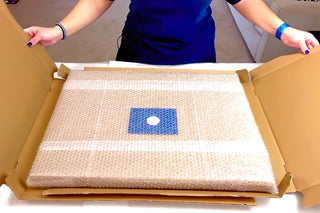Art print of One of the Four Ceiling Sketches in the Vatican Gallery - Henry Swinburne


View from behind

Frame (optional)
A look at sacred architecture: the finesse of "One of the Four Ceiling Sketches in the Vatican Gallery"
This sketch accurately captures the ornamental splendor of the Vatican ceilings, blending architectural lines and delicate decorative motifs. Shades of gray and ochre, worked with line and shadow, restore the depth of the vaults and the richness of the moldings, while the composition highlights the perspective turned toward the interior sky. The overall atmosphere is both contemplative and structured, inviting the viewer to explore every detail. This art print reproduces the clarity of the line and the subtlety of contrasts, ideal for appreciating the technique and emotion of the original drawing.
Henry Swinburne, heritage observer and draftsman
Henry Swinburne, traveler and draftsman of the 18th–19th century, distinguished himself through his architectural surveys and studies of monuments. Influenced by the topographical tradition and a taste for Antiquity, he rigorously documented the décors and facades encountered during his stays in Italy. His drawings, often precise and descriptive, constitute a valuable testimony for the history of restoration and the study of decorative arts. This work is part of a practice where attentive observation serves both science and aesthetics, making this sketch a relevant artistic and historical document.
A decorative acquisition with multiple assets
Adopting this art print of "One of the Four Ceiling Sketches in the Vatican Gallery" brings architectural elegance to any interior: living room, office, library, or entryway. The format easily integrates into a contemporary or classical wall composition, and the subdued palette complements a wide range of color schemes. Print quality and fidelity of details ensure that the artwork "One of the Four Ceiling Sketches in the Vatican Gallery" preserves the spirit of the original drawing, while the canvas offered provides a texture that enhances the readability of the lines. This decorative choice combines historical craftsmanship with a discreet yet assertive visual presence.

Matte finish

View from behind

Frame (optional)
A look at sacred architecture: the finesse of "One of the Four Ceiling Sketches in the Vatican Gallery"
This sketch accurately captures the ornamental splendor of the Vatican ceilings, blending architectural lines and delicate decorative motifs. Shades of gray and ochre, worked with line and shadow, restore the depth of the vaults and the richness of the moldings, while the composition highlights the perspective turned toward the interior sky. The overall atmosphere is both contemplative and structured, inviting the viewer to explore every detail. This art print reproduces the clarity of the line and the subtlety of contrasts, ideal for appreciating the technique and emotion of the original drawing.
Henry Swinburne, heritage observer and draftsman
Henry Swinburne, traveler and draftsman of the 18th–19th century, distinguished himself through his architectural surveys and studies of monuments. Influenced by the topographical tradition and a taste for Antiquity, he rigorously documented the décors and facades encountered during his stays in Italy. His drawings, often precise and descriptive, constitute a valuable testimony for the history of restoration and the study of decorative arts. This work is part of a practice where attentive observation serves both science and aesthetics, making this sketch a relevant artistic and historical document.
A decorative acquisition with multiple assets
Adopting this art print of "One of the Four Ceiling Sketches in the Vatican Gallery" brings architectural elegance to any interior: living room, office, library, or entryway. The format easily integrates into a contemporary or classical wall composition, and the subdued palette complements a wide range of color schemes. Print quality and fidelity of details ensure that the artwork "One of the Four Ceiling Sketches in the Vatican Gallery" preserves the spirit of the original drawing, while the canvas offered provides a texture that enhances the readability of the lines. This decorative choice combines historical craftsmanship with a discreet yet assertive visual presence.






